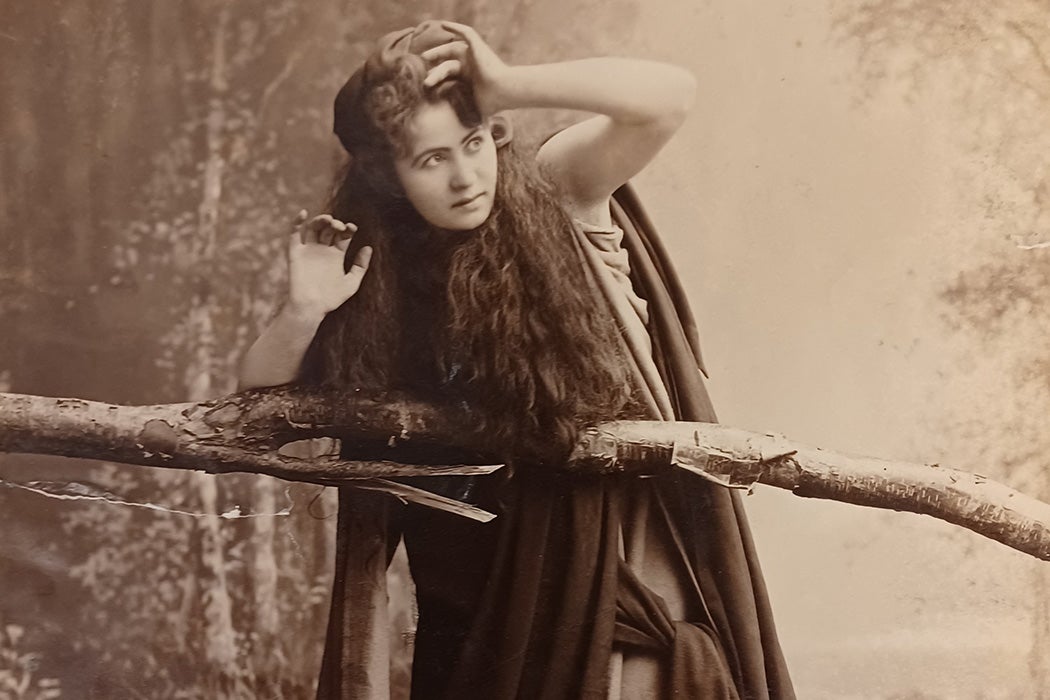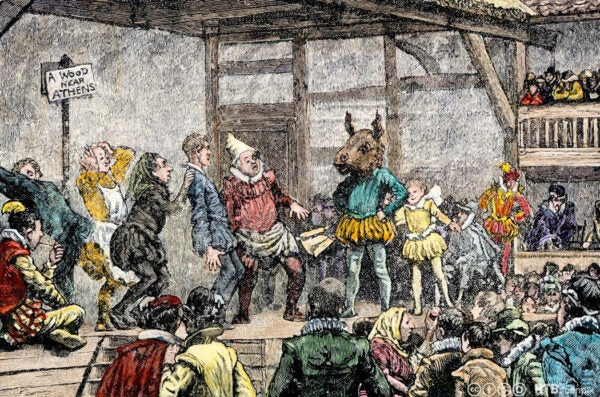Meet Rose Levere, a member of one of the earliest generations of women to earn a law degree from New York University and in the country at large. A notable achievement in itself for 1892, it represented but one chapter in the unusual life of an accomplished, self-made, multi-hyphenate, eccentric maverick, a pioneer whose story has never been told. In addition to her legal pursuits, Levere was an internationally recognized actress and a flamboyant spiritualist who published a reviled volume of essays by the likes of Pontius Pilate, Charles Darwin, and Clara Barton–all of whom, she claimed, conveyed their thoughts to her from the afterlife. Through it all, Levere manipulated the public eye with a savvy even the Kardashian clan might admire.
Tracing Levere’s life-long course of reinvention offers perspective on the era in which she lived. It’s both a tale of an immigrant’s self-realization and an object lesson of how a disenfranchised woman might take full advantage of new opportunities coming her way. Levere’s journey also offers a closeup of a compelling, complicated individual—a restless, progressive Renaissance woman, a grandiose, off-kilter operator, or perhaps, both.
Rosa Wice Levy Levere: An Ambitious Girl, Said to Be Very Clever
Born Rosa Wice in 1848 in Koenigsburg, Prussia, now part of Russia, she moved with her family, which grew to eight siblings, to New York City as a young child. She became principal of a synagogue Sunday school at 18 and graduated from the Normal College of the City of New York, a newly-founded secondary school aimed at teacher training for girls. The credential helped her get a job teaching in a downtown grammar school. She married and at 22 became Mrs. Benjamin Levy.
No record of Levere’s married life endures. There is no evidence that she and her husband, a merchant, had children or divorced. No historical documents indicate when or how her husband died, though later City Directory data from 1911 identifies her as a widow. What’s clear is that by 1881, Mrs. Levy was now Rose Levere, Thespian.
The next seven years were a whirlwind for Levere personally and for the American theater scene more generally. Massive expansion in rail transportation and breakthroughs in communication technology had created a boom in the dramatic arts and media. By 1900, the country had almost three hundred touring companies and the American Newspaper Directory listed more than 20,000 periodicals in print. In this new media landscape, galvanized by P.T. Barnum’s outsized exploitation of the press, theaters invested heavily in publicity to promote their shows and performers, a strategy Levere seems to have absorbed.
At the same time, integral changes to the theatrical experience opened it up to women, both as audience members and actors. Theater’s historical reputation as a hotbed of prostitution and violence had changed by the second half of the 19th century, making it acceptable for middle-class matrons and matinee girls alike to see a show. On the flip side, actresses who were once considered near-courtesans were now regarded with greater respect, and could earn an honest—and independent—wage equal to that of men. Women jumped at the opportunities theater work offered; between 1870 and 1880, the number of women who self-identified as actresses jumped nearly 600 percent, according to the U.S. census.
Levere was busy. She appeared in productions by Augustin Daly and other impresarios, playing small parts in melodramas. She toured with William Horace Lingard’s company in 1883, making stops in Kansas, Los Angeles, and elsewhere. By 1885, she had formed her own troupe, the better to star in plum roles like Shakespeare’s Juliet, and Leah the Forsaken, (recently revived), a hugely popular tragic romance, about a Jewish refugee in an Austrian town who falls for a Christian man.
Reviews of her work varied. She “plays with taste and feeling,” wrote the critic for the Jewish Messenger, and a reviewer in the New York Graphic remarked that, “Nature has endowed her with a beautiful face and careful cultivation of the elements of her profession has done the rest. Few young actresses give better promise of a brilliant future.”
On the other hand, a critic for the London Era found Levere “as insipid a Juliet as can be found.” Before long there was no more cause for such notices. Owing in part to financial troubles, Levere closed her company and set out in an altogether new direction.
Rose Levere, LLB
Levere earned her law degree in 1892, and the next year became the first woman in her New York State district to enter the bar. In doing so, she joined the ranks of a miniscule elite; there were 208 female lawyers in the U.S. in 1890—and 89,422 male ones. Whether Levere beguiled the press in her new career or enlisted the services of a press agent, a syndicated profile of her as pioneering lawyer appeared in papers in Missoula, Sioux City, and Connecticut. It noted “a confidence in her own future which is truly sublime.” Law, the profiled continued, was Levere’s first love, and she possessed the ability to “see through a person at first glance and tell whether that person is telling the truth.” Moreover, wrote a reporter in the Illustrated American, Levere possessed “socialist tendencies,” and the author of the syndicated profile said she was “full of energy, surcharged with radical views.”
There is no record of what Levere accomplished as a lawyer. She advertised herself in the New York Times as “instructor in forensic elocution” and a “reader on jurisprudence, ancient and modern law” in 1892, which may have been her attempt to get around a prohibition against attorneys overtly advertising their services. That little is known about Levere’s legal career is not surprising given that even credentialed women were more or less shut out of the courtroom. Women lawyers often took positions in back offices or as informal advocates, if they didn’t leave profession altogether.
For her part, Levere threw herself into a wide range of other professional and civic causes. She became a founding member of the Women’s Lawyers Club, the forerunner to the National Association of Women Lawyers, and was active in the Actors Fund and the National Association of Elocutionists. She was vice president of the Amelia Relief Society, a Jewish women’s charity and, in 1898 took part in a multi-day philanthropy training for men and women. She also became involved with the Freemasons, a fraternal order traditionally heralded for its religious tolerance but not, around1850, for its inclusion of women. The theatricality characteristic of Freemasons—they wore robes and had detailed rites and rituals—surely appealed to Levere. She joined the newly-established Eastern Order, the organization’s women’s auxiliary and became part of an illustrious global lineage that counted among its members eight presidents, as well as luminaries like William Hogarth, Mark Twain, and Mozart.
Scientific Proofs of Another Life, Compiled by Rose Levere, LLB
The Freemasonry Levere encountered, with its hint of the supernatural was tame compared to the dramatic, otherworldly spiritualism taking the country by storm around this same time. Levere soon joined the millions of Americans who considered themselves spiritualists after the Civil War.
Most scholars say that spiritualism took shape in the “Burned-Over” district in the western part of New York state in the 1840s, beginning with the Fox Sisters and their spirit rappings. The unprecedented grief caused by Civil War casualties combined with the rapid pace of technological advancement created a hunger among Americans to make sense of their time. Spiritualism offered a means to do so, however unlikely it was. But the difficult-to-fathom reality of telephonic and telegraphic communication allowing distant individuals to connect through invisible waves made the notion of the dead sending messages seem plausible. Spiritualism adopted a scientific mantle if not a scientific approach to prove its claims. Levere’s involvement with spiritualism took this tack, too, culminating with her publication, in 1913, of the immodestly titled A Modern Spiritualistic Classic; Scientific Proofs of Another Life. A Series of Essays Comprising Unique Lessons of Daily Life, Written by Eminent Persons after Passing from Mortal to Spirit life. It was just one volume on the topic among the thousands published between 1850 and 1910.
Levere’s preface demonstrates unabashed pride in the work. It is, she wrote, one of “the most remarkable and unique literary compilations ever given to the world.” The volume of 70 “essays” is attributed to a spectacular who’s who. Almost all the essays are illustrated by “self-portraits” said to be “drawn independently by the spirit artists themselves.”
The essays are indistinguishable from one other, in style and theme, and barely cogent. Lincoln discusses pickpockets; Moses, who cometh “this night in the city of New York,” chides the multitudes for interrupting “the writing and talking seance.” Socrates tells of a child asking its father, “Why is it I feel so good when the train goes fast?”
Notable among the “essayists” are the progressives. Susan B. Anthony, Elizabeth Wright-Menafee, Phoebe Cary, Elizabeth Cady Stanton, and Lucretia Mott were among the suffragists, abolitionists, and advocates for equal education featured in the book. Their inclusion raises the question: Was Levere a true believer in spiritualism, or did she recognize, as many women did, spiritualism’s tremendous potential for women in providing a platform for women to opine on any number of pressing social issues?
The Victorian trope of women as angels of the house, the morally superior of the sexes, cast them as better vessels for the spirits. And during a time when women were strongly discouraged from public speaking, not to mention preaching, this was a sanctioned opportunity. Moreover, there was money to be made. Spiritualism sustained a booming economy of goods and services—from Ouija boards to speaker fees. Levere threw herself into this market with her entrepreneurial flair, self-publishing her book via her own Spiritual Science Company. She made sure the press got copies.
Critics panned it, but Levere remained involved with the spiritualist movement. She became the long-time pastor of the Church of Divine Inspiration, whose newspaper ads touted her as “leader,” and publicized both “psychic demonstrations” and talks by well-known spiritualists like W.J. Colville and Dr. Frederick Keeler.
Spiritualism was Levere’s last, grandest hurrah as a public figure. Her private life was more opaque; we don’t quite know how she kept body and soul together. What is known is that Levere bought and sold property in Manhattan, sometimes in partnership with a brother who lived in New Jersey. These transactions may have financed or subsidized Levere’s forays into some of the pioneering movements and professions of her day.
She died in 1923 at her brother’s hotel in Hackensack, and left behind little of material value: a sheepskin coat, three guitars, a banjo, linens. Her legacy, on the other hand, is rich. Fearlessly, Levere navigated barriers that many women today still face. She tackled one frontier after another, determined to show the public just what she could do in a strikingly modern way.
Support JSTOR Daily! Join our new membership program on Patreon today.







